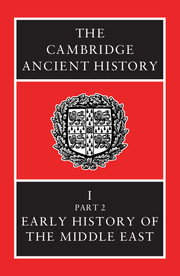Book contents
- Frontmatter
- Contents
- List of Maps
- List of Tables
- List of Text-figures
- Preface
- CHAPTER XI THE EARLY DYNASTIC PERIOD IN EGYPT
- CHAPTER XII THE LAST PREDYNASTIC PERIOD IN BABYLONIA
- CHAPTER XIII THE CITIES OF BABYLONIA
- CHAPTER XIV THE OLD KINGDOM IN EGYPT AND THE BEGINNING OF THE FIRST INTERMEDIATE PERIOD
- CHAPTER XV PALESTINE IN THE EARLY BRONZE AGE
- CHAPTER XVI THE EARLY DYNASTIC PERIOD IN MESOPOTAMIA
- CHAPTER XVII SYRIA BEFORE 2200 B.C.
- CHAPTER XVIII ANATOLIA, c. 4000–2300 b.c.
- CHAPTER XIX THE DYNASTY OF AGADE AND THE GUTIAN INVASION
- CHAPTER XX THE MIDDLE KINGDOM IN EGYPT: INTERNAL HISTORY FROM THE RISE OF THE HERACLEOPOLITANS TO THE DEATH OF AMMENEMES III
- CHAPTER XXI SYRIA AND PALESTINE c. 2160–1780 b.c.
- CHAPTER XXII BABYLONIA, c. 2120–1800 B.C.
- CHAPTER XXIII PERSIA, c. 2400–1800 B.C.
- CHAPTER XXIV (a) ANATOLIA, c. 2300–1750 B.C.
- CHAPTER XXIV(b) ANATOLIA IN THE OLD ASSYRIAN PERIOD
- CHAPTER XXV ASSYRIA, c. 2600–1816 B.C.
- CHAPTER XXVI(a) GREECE, CRETE, AND THE AEGEAN ISLANDS IN THE EARLY BRONZE AGE
- CHAPTER XXVI(b) CYPRUS IN THE EARLY BRONZE AGE
- CHAPTER XXVII IMMIGRANTS FROM THE NORTH
- BIBLIOGRAPHIES
- Chronological Tables
- Index to Maps
- General Index
- Map 6. Babylonia and Western Persia.
- Map 12. Early Bronze Age sites in Greece and the Aegean Islands.
- Map 16. Map to illustrate movements of northern peoples in the third to first millennia B.C.
- References
CHAPTER XII - THE LAST PREDYNASTIC PERIOD IN BABYLONIA
Published online by Cambridge University Press: 28 March 2008
- Frontmatter
- Contents
- List of Maps
- List of Tables
- List of Text-figures
- Preface
- CHAPTER XI THE EARLY DYNASTIC PERIOD IN EGYPT
- CHAPTER XII THE LAST PREDYNASTIC PERIOD IN BABYLONIA
- CHAPTER XIII THE CITIES OF BABYLONIA
- CHAPTER XIV THE OLD KINGDOM IN EGYPT AND THE BEGINNING OF THE FIRST INTERMEDIATE PERIOD
- CHAPTER XV PALESTINE IN THE EARLY BRONZE AGE
- CHAPTER XVI THE EARLY DYNASTIC PERIOD IN MESOPOTAMIA
- CHAPTER XVII SYRIA BEFORE 2200 B.C.
- CHAPTER XVIII ANATOLIA, c. 4000–2300 b.c.
- CHAPTER XIX THE DYNASTY OF AGADE AND THE GUTIAN INVASION
- CHAPTER XX THE MIDDLE KINGDOM IN EGYPT: INTERNAL HISTORY FROM THE RISE OF THE HERACLEOPOLITANS TO THE DEATH OF AMMENEMES III
- CHAPTER XXI SYRIA AND PALESTINE c. 2160–1780 b.c.
- CHAPTER XXII BABYLONIA, c. 2120–1800 B.C.
- CHAPTER XXIII PERSIA, c. 2400–1800 B.C.
- CHAPTER XXIV (a) ANATOLIA, c. 2300–1750 B.C.
- CHAPTER XXIV(b) ANATOLIA IN THE OLD ASSYRIAN PERIOD
- CHAPTER XXV ASSYRIA, c. 2600–1816 B.C.
- CHAPTER XXVI(a) GREECE, CRETE, AND THE AEGEAN ISLANDS IN THE EARLY BRONZE AGE
- CHAPTER XXVI(b) CYPRUS IN THE EARLY BRONZE AGE
- CHAPTER XXVII IMMIGRANTS FROM THE NORTH
- BIBLIOGRAPHIES
- Chronological Tables
- Index to Maps
- General Index
- Map 6. Babylonia and Western Persia.
- Map 12. Early Bronze Age sites in Greece and the Aegean Islands.
- Map 16. Map to illustrate movements of northern peoples in the third to first millennia B.C.
- References
Summary
SOURCES AND GENERAL CHARACTER OF THE PERIOD
Towards the middle of the fourth millennium B.C., civilization in the plain of the Euphrates and the Tigris was not dissimilar to that of western Asia in general, as described in the foregoing chapters. Everywhere we find farmers and stock-breeders, in possession of all the requisite crafts, obtaining a few commodities from abroad, and little given to change. Similar peasant cultures—settled, stagnant and uncentralized—existed in Neolithic times throughout Europe and Asia, and continued to exist there for centuries after the ancient Near East had evolved a more complex mode of life, and had, through the diffusion of metallurgy, brought about an improvement in the equipment of the populations of Asia and Europe. If we judge by their remains, these people do not appear inferior to the early inhabitants of the ancient Near East and of Egypt described in chapters vii–ix above. We cannot explain why the latter set out on a course which led to achievements surpassing all that had gone before. In prehistoric times the future centres of high civilization showed no signs of being exceptional. On the contrary, each of them formed part of a larger cultural province: Egypt shared its early pre-dynastic civilization with Libya, Nubia and perhaps the Sudan; northern Mesopotamia was at first indistinguishable from north Syria; southern Mesopotamia was intimately linked with Persia. It was the unprecedented development described in this and the preceding chapter which differentiated Egypt and Mesopotamia from their surroundings, as it also established their unique historical significance.
- Type
- Chapter
- Information
- The Cambridge Ancient History , pp. 71 - 92Publisher: Cambridge University PressPrint publication year: 1971

